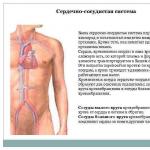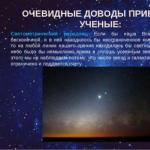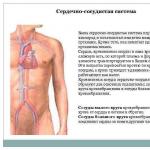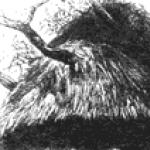Presentation on the theme of the universe. Astronomy presentation on the topic "universe"
1 slide
Is our Universe infinite? Prepared by student 11-A SZSh No. 80 Gerasimenko Karina

2 slide
OBVIOUS ARGUMENTS ARE PROVIDED BY SCIENTISTS: Photometric paradox. If our Universe were infinite, and there were an unlimited number of stars in it, then on any line of our vision there would be a luminous star, and the sky would be unimaginably bright and completely dotted with stars. However, we do not observe this because the number of stars and galaxies in the Universe is limited and can be counted.

3 slide
Gravitational paradox. If there were an infinite number of cosmic objects in our Universe, then the force of gravity would become so great that any movement of material bodies in the Universe would simply be impossible.

4 slide
Radioactive decay of matter. All chemical elements that make up a substance are radioactive to one degree or another and are subject to radioactive decay or annihilation. If the Universe existed for an infinitely long time, then within an eternity all matter would have annihilated long ago.

5 slide
Thermal paradox. Everywhere in the Universe, the law of entropy prevails, according to which energy or heat from hotter bodies moves to colder bodies until thermal equilibrium is established between them. This energy balance, if the Universe were eternal in time, would have been established long ago, but this does not happen and does not exist.

6 slide
Expansion of the Universe. The structure of the Universe is constantly expanding at an acceleration of 1/3 of its radius in about a million years. Its most distant galaxies are moving away from us at a speed of 150,000 kilometers per second. If this rate of expansion of the Universe is started in the opposite direction, then after about 14 billion years all the matter of the Universe will gather at one point. Consequently, our Universe arose approximately at that distant time, 13.7 billion years ago, as evidenced by the trace of the Big Bang - relict radiation.

7 slide

8 slide
However, scientists admit: If the Universe is infinite, then from a mathematical point of view it turns out that somewhere there is an exact copy of our planet, since there is a possibility that the atoms of the “double” occupy the same position as on our planet. The chances that such an option exists are negligible, but in an infinite Universe this is not only possible, but also must happen, and at least an infinite number of times, provided that the Universe is still infinitely infinite.

Slide 9
However, not everyone is convinced that the Universe is infinite. Israeli mathematician, Professor Doron Selberger, is convinced that numbers cannot increase indefinitely, and there is a number so huge that if you add one to it, you get zero. However, this number and its meaning are far beyond human understanding and it is likely that this number will never be found or proven. This belief is the central tenet of the mathematical philosophy known as Ultra-Infinity.
summary of other presentations“Structure of organisms, class 5” - Integumentary and conductive. TISSUE – a group of cells similar in structure and functions. Single-celled organisms include bacteria, fungi, and protozoa. Human. Nature lesson. Unicellular organisms. Diversity of living organisms. Plants. Multicellular organisms. Connecting. Epithelial. T kan i. Multicellular organisms include plants, animals, and fungi. 5th grade. The structure of organisms. In unicellular organisms, the body consists of one cell.
“Inhabitants of the continents” - Sequoia is a unique tree. Africa is unique with its fabulously rich nature. Australia is the only country in the world that occupies the entire continent. South America. Life on different continents. Baobab is one of the most famous plants in Africa. In a trunk up to 10 m thick, the baobab stores water (up to 120 tons). The flora and fauna of Tropical and Southern Africa are extremely rich and diverse.
“Reproduction of living organisms” - Sex cells (gametes). From two cells, male and female, one cell is formed - a zygote (from the Greek. Development of a new organism from a zygote. Living organisms produce new generations of similar organisms. Parents. A new organism appears a certain time after the formation of the zygote: Kotlyarevskaya. Scheme of sexual reproduction. Zegotos - “connected together”). Descendants. Male gamete Female gamete Zygote New organism.
“Diversity of substances, natural history” - Can inorganic substances be simple and complex? Give examples. What new did you learn in class today? All substances are divided into simple and complex. Fill out the tables: Reflection. Molecules of inorganic substances mainly consist of a small number of atoms. Variety of substances. From previous natural history lessons, remember the bodies of living and inanimate nature. Organic substances: proteins, fats and carbohydrates. Which of these substances are simple and which are complex? What was interesting for you?
“Universe 5th grade natural history” - Universe. Attention attention! The speed of our Galaxy is 1 million 500 thousand km per hour. Spiral Galaxy 4414. Objective of the lesson: Key: 1-c, 2-b, 3-b, 4-c, 5-c, 6-b, 7-c, 8-a, 9-c, 10-c, 11 -a, 12-a, 13-c, 14-c, 15-b. Milky Way. Constellations.
“Mushrooms 5th grade” - Mushrooms are living organisms. Mushrooms are living organisms! The structure of a cap mushroom. Variety of mushrooms. Mushrooms. Edible mushrooms. Lesson for 5th grade Khodolev Yu.V. Natural history teacher at school No. 186. Main properties: - breathing - nutrition - growth - reproduction - aging. T a n t e n t .
Universe
Slides: 26 Words: 139 Sounds: 0 Effects: 56Universe. Celestial bodies: - stars; - planets; - satellites of the planets; - asteroids; - comets. Ideas about the structure of the Universe. Ptolemy. Aristotle. Copernicus. Solar system. Composition of the Solar System. Planets Stars Asteroids Comets Meteors and meteorites The Sun is the center of the Solar System. Planets. Terrestrial group Mercury Venus Earth Mars. Giant planets Jupiter Saturn Uranus Neptune. the smallest is Pluto. Jupiter. Saturn. Neptune. Uranus. Comet. Constellations. Assignments: What is the Universe? What is the Solar System? What two groups are planets divided into? What is the difference between a meteor and a meteorite? - Universe.ppt
universe space
Slides: 7 Words: 218 Sounds: 0 Effects: 0Space. The universe is the totality of everything that exists physically. The starry sky is a small part of the boundless space. What's next? Are there other creatures like us somewhere else? What to expect from space - good or evil? What is space? The first space photographs were taken in 1961 by German Titov. At the same time, visual observation of the earth's surface by spacecraft crews began. You can see the entire Dnieper - from source to mouth. - Universe space.ppt
Star Universe
Slides: 25 Words: 1386 Sounds: 0 Effects: 43Universe. Space. Ancient people. Centuries have passed. Stars. Sun. Different stars. Planets. Solar system. Mercury. Venus. Earth. Moon. Mars. Jupiter. Saturn. Uranus. Neptune. Pluto. Astronomical counting table. Asteroids. Check yourself. - Star Universe.pptx
Structure of the Universe
Slides: 47 Words: 1175 Sounds: 0 Effects: 0The structure of the Universe. Structural-scale “ladder”. Ladder. Structural-time “scale”. “Cellular” structure of the Metagalaxy. “Flat” structure of the Metagalaxy. Superclusters of Galaxies. Observatory. The largest structure in the Universe. Structure. Groups of Galaxies. Local group of galaxies. Galaxies. Milky Way. Star clusters. Planetary systems. Systems. Neighborhood. Solar system. System. Nemesis. Oort cloud. Asteroid belt. Largest asteroids. Asteroid belt "Inner". Asteroids. “Gravity” map in conventional colors. Crater. Snow. Quicksand. - Structure of the Universe.ppt
Models of the Universe
Slides: 27 Words: 859 Sounds: 0 Effects: 29Models of the Universe. Anaximander. Questions. The structure of the Universe. Pythagoras of Samos. The system of the world of the Pythagorean Philolaus. Direct and retrograde motion of planets. Aristotle. Aristarchus of Samos. Claudius Ptolemy. Location of celestial bodies. Sun. Heliocentric system. Monument to Copernicus in Warsaw. Monument to Copernicus. Giordano Bruno. A number of guesses. Monument to Giordano Bruno. Galileo. Galileo decides to publicly renounce his faith. Telescope. Tombstone. Ancient people. At the center of the Universe is the Sun. Italian scientist. - Models of the Universe.ppt
Cosmological models
Slides: 89 Words: 2537 Sounds: 0 Effects: 4Introduction to cosmology. Cosmological models. Hubble's law. Removing all bodies does not mean the existence of an expansion center. Redshift. Wavelength shift. Reasons for changing wavelength. Doppler effect. Exact formula. Expansion of space. Integral formula. Redshift of the galaxy. The essence of the Hubble constant. Metagalaxy. Newtonian cosmology. Cosmological models. Newtonian cosmology. The coordinate changes according to the law. Laws of conservation of mass. Law of conservation of mechanical energy for an element at the edge of a ball. Let's write down the total mechanical energy. Dynamic properties of the cosmological model. - Cosmological models.ppt
Life and Mind
Slides: 26 Words: 1059 Sounds: 0 Effects: 72Life and intelligence in the Universe. UFO - unidentified flying object). What are all our great geographical discoveries worth compared to the upcoming expedition to Mars? Others argue that the universe is simply teeming with different forms of life. Often UFOs are seen on the road, but only when there is no one around. There is a lot of evidence of hostile behavior of UFOs. Let us list the main phenomena that cause reports of UFOs. Atmospheric. The Moon and Venus are often the culprits in UFO reports. Why are scientists skeptical of all kinds of reports about UFOs and aliens from other worlds? - Life and Mind.ppt
Life in the Universe
Slides: 33 Words: 1425 Sounds: 12 Effects: 25Life and intelligence in the Universe. Introduction. There is nothing more exciting than the search for life and intelligence in the Universe. Man will not rest until he solves the mystery of his origin. I want to learn about distant cosmic worlds, about the Universe. The emergence of the mind. Most likely no! Attempts have long been made to discover and establish contact with other civilizations. The emergence of life on Earth. Searches for life in the solar system. No traces of organic life have been found on the Moon. There is no atmosphere, and the surface temperature varies from –170 to 450? C. Unfortunately, due to its proximity to the Sun, Venus is not at all like Earth. - Life in the Universe.ppt
Extraterrestrial civilizations
Slides: 13 Words: 274 Sounds: 0 Effects: 2Searches for extraterrestrial civilizations. The 26-meter radio telescope of the US National Radio Astronomy Observatory in West Virginia. Techniques. Look for signals from extraterrestrial civilizations. Send the so-called “ready signal”. SAO RAS radio telescope RATAN-600 operating in the centimeter and decimeter ranges. Classification of civilizations. The first type of civilization uses energy on a planetary scale. Supercivilization. Our Galaxy. A black hole is a corridor to other worlds. The problem of paleocontacts. The Japanese dogu figurines bear a strong resemblance to some kind of clumsy spacesuit. UFO problem. - Extraterrestrial civilizations.ppt
Extraterrestrial life forms
Slides: 21 Words: 832 Sounds: 21 Effects: 88Search and study of extraterrestrial life forms. Criteria for the existence and search of living systems. A practical overview of the search and research of extraterrestrial life forms. Sergei Pavlovich Korolev. Yuri Gagarin. Direct interest in the problem of searching for intelligent life. Definition of life on other planets. Our ideas about the essence of life. About the chemical basis of life. General dynamic properties of living systems. The role of light in maintaining life. Methods for detecting extraterrestrial life. Discovery of life forms similar to terrestrial animals. Moon. Venus. Mars. Meteorites. Search for extraterrestrial civilizations. -
All about the Universe
Astronomy page
Question: What is the Universe? The Universe is outer space filled with celestial bodies, gas and dust
This is interesting. The Universe is so huge that it is impossible to comprehend its size. Let's talk about the Universe: the part of it that is visible to us extends over 1.6 million million million million km - and no one knows how large it is beyond the visible. According to the most popular theory, 13 billion years ago it was born as a result of a giant explosion. Time, space, energy, matter - all this arose as a result of this phenomenal explosion. It’s pointless to say what happened before the so-called “big bang”, there was nothing before it
Historical page
Ancient Egyptians. Ancient Babylonians. Ancient Indians. Ancient people's idea of the universe
Connect the models of the Universe and their creators with lines.
Continuers of the idea of Copernicus Giordano Bruno Galileo Galilei
Literary page “Solar System”
This yellow star always warms us, illuminates all planets, protects us from other stars.
Six sons and two daughters are running around the light, Years and days will flash by, But they will not meet.
The tiny planet is warmed by the First Sun, and is agile - the year on it is Eighty-eight days.
Only the Sun and Moon in the sky are brighter than her. And there is no hot planet in the solar system.
There are miracles on the planet: Oceans and forests, Oxygen is in the atmosphere, People and animals breathe it.
Kamenyuki Fear and Horror are circling over the red planet. There is no mountain anywhere in the world Higher than on that planet.
A heavyweight giant Throws lightning from the sky, He's striped like a cat, It's a pity he's losing weight little by little.
Lush gas giant Brother of Jupiter and dandy He loves to have Rings of ice and dust nearby.
He has been a Greek among his Roman brothers for many centuries, And rushes through the cosmos of melancholy, lying on his side.
On the planet blue, the wind is blowing very strong. The year on it is very long - winter lasts 40 years.
It takes five hours for the light to reach that planet, and therefore it is not visible in telescopes.
Map of the Solar System (compiled by Petya) Pluto Mercury Neptune Uranus Mars Venus Earth Saturn Jupiter
Cosmic physical exercise: Cosmic physical exercise
Astronomy page
Asteroids
Meteorites
THINK! Specify our Galaxy
Geographic page
Infinite:_________ Our Galaxy ____________________ Solar system Planet _____________ Continent _____________ ______________ region District _______________ District _______________ Village ________________ Infinite Universe and our address in it:
Infinite: Universe Our Galaxy Milky Way Solar System Planet Earth Continent Eurasia Tyumen Region Yamalo-Nenets Autonomous Okrug District Priuralsky Village Katrovozh Infinite Universe and our address in it.
“Cosmic Life” - Belka and Strelka. Yuri Alekseyevich Gagarin. Solar system. FIRST WOMAN COSMONAUT Valentina Tereshkova. The first man on the moon. Baikonur Cosmodrome. The work was completed by Victoria Akishina, 2nd grade “A” student of State Budget Educational Institution Gymnasium No. 1597. Our Universe. Spaceship "VOSTOK". The first Soviet cosmonauts.
"Space Research" - Space Education. Preparation of the program for the International Geophysical Year IGY’1957. Continuous global observations are needed to study and predict “space weather.” The period of active existence is at least 2 years. As a result of an ordinary breakdown in a strong electric field, the resulting high-energy electrons escape.
“Game about space” - 500. “Vostok – 7”. In what year did the first manned space flight take place? 1200. 400. Bug. Game over Your score: 0. "Sunrise". Who was the first person to fly into space? 100. Game over Your score: 800. Geese. "Children of the Galaxy" 600. Yu. Gagarin.
"Conquest of Space" - Conquest of Space. On April 12, 1961, the Vostok spacecraft rose to an altitude of 327 km. A monument was erected at the landing site of Yuri Gagarin. Cosmonaut No. 2. First flight to space. Gymnasium 42. Fly like birds! Alexey Leonov was the first to go into outer space. The first aircraft designers. Our fellow countryman German Titov was the second to fly into space.
“The problem of space exploration” - Space debris is dangerous not only for astronauts and space technology, but also for earthlings. Moreover, a distinction is made between observable and unobservable space debris, the amount of which is unknown. Problems of global space exploration. Therefore, space exploration has become one of the most important international and global problems.
“The History of Space” - We were faced with the difficult task of embracing the immensity. S.P. Korolev. With a diameter of 580 mm, the mass of the first satellite was 83.6 kg. Therefore, in our creative work we limited ourselves to studying the development of astronautics in Russia. In 1947 he graduated from the Mariinsky Posad Forestry Technical School. Tsiolkovsky developed the theory of jet propulsion, the basis of modern rocket and space technology.
There are a total of 38 presentations in the topic





